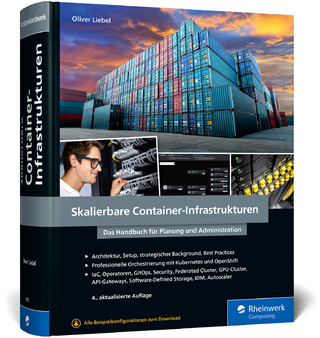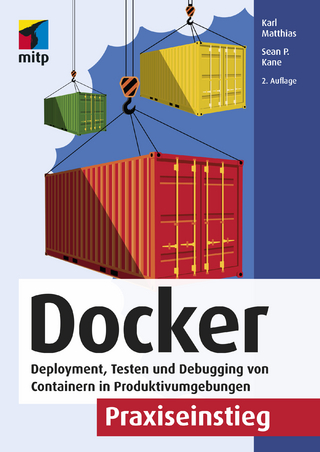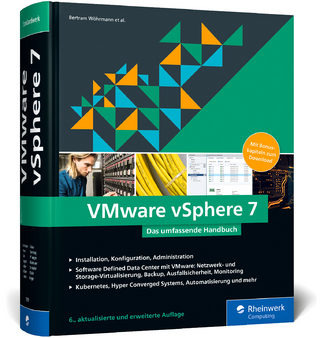
Essential Virtual SAN (VSAN)
VMWare Press (Verlag)
978-0-13-451166-5 (ISBN)
- Keine Verlagsinformationen verfügbar
- Artikel merken
VMware's Virtual SAN has rapidly proven itself in environments ranging from hospitals to oil rigs to e-commerce platforms. Along the way, it has matured to offer unsurpassed features for data integrity, availability, and space efficiency. Virtual SAN 6.x makes all-flash storage practical for even more use cases, while radically simplifying IT operations and supporting the transition to hyper-converged infrastructures (HCI). Now, the authors of Essential Virtual SAN (VSAN) have thoroughly updated their definitive guide to this transformative technology. Writing for vSphere administrators, architects, and consultants, Cormac Hogan and Duncan Epping explain what Virtual SAN is, how it has evolved, what it now offers, and how to gain maximum value from it.
Hogan and Epping draw on unsurpassed experience shaping Virtual SAN and helping VMware customers deploy it. They offer expert insight into preparation, installation, configuration, policies, provisioning, clusters, and more. You'll also find practical guidance for using its new Health and Performance Services to gain end-to-end visibility into infrastructure and resource consumption. Both an up-to-the-minute reference and hands-on tutorial, Essential Virtual SAN, Second Edition uses realistic examples to demonstrate the immense power of Virtual SAN 6.x. You'll learn all you need to successfully plan and deploy the newest versions, and operate them smoothly and efficiently.
COVERAGE INCLUDES:
Understanding the goals and concepts of Software-Defined Storage and Virtual SAN
Meeting updated requirements for safe Virtual SAN 6.x implementation
Architecting, installing, and configuring Virtual SAN for your unique environment
Simplifying deployment with VM storage policies and provisioning
Controlling availability, performance, and reliability
Efficiently managing and maintaining Virtual SAN
Providing resiliency and scale-out storage functionality
Designing and sizing clusters (with examples)
Using stretched clusters to address rigorous downtime requirements
Applying valuable new features such as deduplication, compression, checksums, and encryption
Using Health and Performance Services to troubleshoot hardware, configurations, and performance
Cormac Hogan is a Senior Staff Engineer in the Office of the CTO in the Storage and Availability business unit at VMware. Cormac was one of the first VMware employees at the EMEA headquarters in Cork, Ireland, back in 2005, and has previously held roles in VMware's Technical Marketing, Integration Engineering and Support organizations. Cormac has written a number of storage-related white papers and has given numerous presentations on storage best practices and new features. Cormac is the owner of CormacHogan.com, a blog site dedicated to storage and virtualization. He can be followed on twitter @CormacJHogan. Duncan Epping is a Chief Technologist working for VMware in the Office of CTO of the Storage and Availability business unit. Duncan is responsible for ensuring VMware's future innovations align with essential customer needs, translating customer problems to opportunities, and function as the global lead evangelist for Storage and Availability. Duncan specializes in Software Defined Storage, hyper-converged infrastructures and business continuity/disaster recovery solutions. He has four patents pending and one granted on the topic of availability, storage and resource management. Duncan is the author/owner of VMware Virtualization blog Yellow-Bricks.com and has various books on the topic of VMware including the "vSphere Clustering Deepdive" series. He can be followed on twitter @DuncanYB.
Foreword by Christos Karamanolis xvii
About the Author xix
About the Technical Reviewers xxi
Acknowledgments xxiii
We Want to Hear from You! xxv
1 Introduction to VSAN 1
Software-Defined Datacenter 1
Software-Defined Storage 2
Hyper-Convergence/Server SAN Solutions 3
Introducing Virtual SAN 4
What Is Virtual SAN? 6
What Does VSAN Look Like to an Administrator? 9
Summary 12
2 VSAN Prerequisites and Requirements for Deployment 13
VMware vSphere 13
ESXi 14
Cache and Capacity Devices 14
ESXi Boot Considerations 15
VSAN Requirements 15
VMware Hardware Compatibility Guide 16
VSAN Ready Nodes 16
Storage Controllers 17
Capacity Tier Devices 19
Cache Tier Devices 21
Network Requirements 22
Network Interface Cards 22
Supported Virtual Switch Types 22
Layer 2 or Layer 3 23
VMkernel Network 23
VSAN Network Traffic 24
Jumbo Frames 24
NIC Teaming 25
Network I/O Control 25
VSAN Stretched Cluster 25
VSAN 2-Node Remote Office/Branch Office (ROBO) 26
Firewall Ports 26
Summary 26
3 VSAN Installation and Configuration 29
VSAN Networking 29
VMkernel Network for VSAN 30
VSAN Network Configuration: VMware Standard Switch 31
VSAN Network Configuration: vSphere Distributed Switch 32
Step 1: Create the Distributed Switch 32
Step 2: Create a Distributed Port Group 33
Step 3: Build VMkernel Ports 34
Possible Network Configuration Issues 38
Network I/O Control Configuration Example 40
Design Considerations: Distributed Switch and Network I/O Control 42
Scenario 1: Redundant 10 GbE Switch Without "Link Aggregation" Capability 43
Scenario 2: Redundant 10 GbE Switch with Link Aggregation Capability 45
Creating a VSAN Cluster 48
vSphere HA 49
vSphere HA Communication Network 49
vSphere HA Heartbeat Datastores 50
vSphere HA Admission Control 50
vSphere HA Isolation Response 51
vSphere HA Component Protection 51
The Role of Disk Groups 51
Disk Group Maximums 52
Why Configure Multiple Disk Groups in VSAN? 52
Cache Device to Capacity Device Sizing Ratio 53
Automatically Add Disks to VSAN Disk Groups 54
Manually Adding Disks to a VSAN Disk Group 55
Disk Group Creation Example 55
VSAN Datastore Properties 58
Summary 59
4 VM Storage Policies on VSAN 61
Introducing Storage Policy-Based Management in a VSAN Environment 62
Number of Failures to Tolerate 65
Failure Tolerance Method 66
Number of Disk Stripes Per Object 69
IOPS Limit for Object 70
Flash Read Cache Reservation 71
Object Space Reservation 71
Force Provisioning 71
Disable Object Checksum 73
VASA Vendor Provider 73
An Introduction to VASA 73
Storage Providers 74
VSAN Storage Providers: Highly Available 75
Changing VM Storage Policy On-the-Fly 75
Objects, Components, and Witnesses 80
VM Storage Policies 80
Enabling VM Storage Policies 81
Creating VM Storage Policies 81
Assigning a VM Storage Policy During VM Provisioning 81
Summary 82
5 Architectural Details 83
Distributed RAID 83
Objects and Components 86
Component Limits 87
Virtual Machine Storage Objects 88
Namespace 89
Virtual Machine Swap 90
VMDKs and Deltas 90
Witnesses and Replicas 90
Object Layout 91
VSAN Software Components 94
Component Management 95
Data Paths for Objects 95
Object Ownership 96
Placement and Migration for Objects 96
Cluster Monitoring, Membership, and Directory Services 97
Host Roles (Master, Slave, Agent) 97
Reliable Datagram Transport 98
On-Disk Formats 98
Cache Devices 99
Capacity Devices 99
VSAN I/O Flow 100
Caching Algorithms 100
The Role of the Cache Layer 100
Anatomy of a VSAN Read on Hybrid VSAN 102
Anatomy of a VSAN Read on All-Flash VSAN 103
Anatomy of a VSAN Write on Hybrid VSAN 103
Anatomy of a VSAN Write on All-Flash VSAN 104
Retiring Writes to Capacity Tier on Hybrid VSAN 105
Deduplication and Compression 105
Data Locality 107
Data Locality in VSAN Stretched Clusters 108
Storage Policy-Based Management 109
VSAN Capabilities 109
Number of Failures to Tolerate Policy Setting 110
Best Practice for Number of Failures to Tolerate 112
Stripe Width Policy Setting 113
RAID-0 Used When No Striping Specified in the Policy 117
Stripe Width Maximum 119
Stripe Width Configuration Error 120
Stripe Width Chunk Size 121
Stripe Width Best Practice 122
Flash Read Cache Reservation Policy Setting 122
Object Space Reservation Policy Setting 122
VM Home Namespace Revisited 123
VM Swap Revisited 123
How to Examine the VM Swap Storage Object 124
Delta Disk / Snapshot Caveat 126
Verifying How Much Space Is Actually Consumed 126
Force Provisioning Policy Setting 127
Witnesses and Replicas: Failure Scenarios 127
Data Integrity Through Checksum 130
Recovery from Failure 131
Problematic Device Handling 134
What About Stretching VSAN? 134
Summary 135
6 VM Storage Policies and Virtual Machine Provisioning 137
Policy Setting: Number of Failures to Tolerate = 1 137
Policy Setting: Failures to Tolerate = 1, Stripe Width = 2 144
Policy Setting: Failures to Tolerate = 2, Stripe Width = 2 148
Policy Setting: Failures to Tolerate = 1, Object Space Reservation = 50% 152
Policy Setting: Failures to Tolerate = 1, Object Space Reservation = 100% 155
Policy Setting: RAID-5 157
Policy Setting: RAID-6 158
Policy Setting: RAID-5/6 and Stripe Width = 2 159
Default Policy 160
Summary 164
7 Management and Maintenance 165
Health Check 165
Health Check Tests 165
Proactive Health Checks 167
Performance Service 168
Host Management 169
Adding Hosts to the Cluster 169
Removing Hosts from the Cluster 170
ESXCLI VSAN Cluster Commands 171
Maintenance Mode 172
Default Maintenance Mode/Decommission Mode 175
Recommended Maintenance Mode Option for Updates and Patching 175
Disk Management 177
Adding a Disk Group 177
Removing a Disk Group 178
Adding Disks to the Disk Group 179
Removing Disks from the Disk Group 180
Wiping a Disk 182
Blinking the LED on a Disk 183
ESXCLI VSAN Disk Commands 184
Failure Scenarios 185
Capacity Device Failure 185
Cache Device Failure 186
Host Failure 187
Network Partition 188
Disk Full Scenario 193
Thin Provisioning Considerations 194
vCenter Management 195
vCenter Server Failure Scenario 196
Running vCenter Server on VSAN 196
Bootstrapping vCenter Server 197
Summary 199
8 Stretched Cluster 201
What is a Stretched Cluster? 201
Requirements and Constraints 203
Networking and Latency Requirements 205
New Concepts in VSAN Stretched Cluster 206
Configuration of a Stretched Cluster 208
Failure Scenarios 216
Summary 224
9 Designing a VSAN Cluster 225
Ready Node Profiles 225
Sizing Constraints 227
Cache to Capacity Ratio 228
Designing for Performance 229
Impact of the Disk Controller 231
VSAN Performance Capabilities 235
Design and Sizing Tools 236
Scenario 1: Server Virtualization-Hybrid 237
Determining Your Host Configuration 238
Scenario 2-Server Virtualization-All-flash 241
Summary 244
10 Troubleshooting, Monitoring, and Performance 245
Health Check 246
Ask VMware 246
Health Check Categories 247
Proactive Health Checks 253
ESXCLI 256
esxcli vsan datastore 256
esxcli vsan network 257
esxcli vsan storage 258
esxcli vsan cluster 262
esxcli vsan faultdomain 263
esxcli vsan maintenancemode 264
esxcli vsan policy 264
esxcli vsan trace 267
Additional Non-ESXCLI Commands for Troubleshooting VSAN 268
Ruby vSphere Console 275
VSAN Commands 276
SPBM Commands 300
Troubleshooting VSAN on the ESXi 303
Log Files 304
VSAN Traces 304
VSAN VMkernel Modules and Drivers 305
Performance Monitoring 305
Introducing the Performance Service 305
ESXTOP Performance Counters for VSAN 308
vSphere Web Client Performance Counters for VSAN 309
VSAN Observer 310
Sample VSAN Observer Use Case 316
Summary 318
TOC, 9780134511665, 5/10/2016
| Erscheinungsdatum | 24.06.2016 |
|---|---|
| Reihe/Serie | VMware Press Technology |
| Verlagsort | NJ |
| Sprache | englisch |
| Maße | 180 x 230 mm |
| Gewicht | 613 g |
| Themenwelt | Informatik ► Betriebssysteme / Server ► Virtualisierung |
| Mathematik / Informatik ► Informatik ► Datenbanken | |
| Mathematik / Informatik ► Informatik ► Netzwerke | |
| Informatik ► Weitere Themen ► Zertifizierung | |
| ISBN-10 | 0-13-451166-2 / 0134511662 |
| ISBN-13 | 978-0-13-451166-5 / 9780134511665 |
| Zustand | Neuware |
| Haben Sie eine Frage zum Produkt? |
aus dem Bereich


